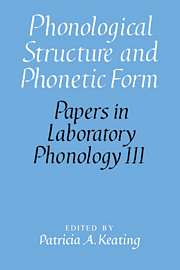Book contents
- Frontmatter
- Contents
- List of contributors
- Acknowledgments
- 1 Introduction
- I Intonation
- II Syllables
- III Feature Theory
- 12 The phonetics and phonology of Semitic pharyngeals
- 13 Possible articulatory bases for the class of guttural consonants
- 14 Phonetic evidence for hierarchies of features
- 15 Do acoustic landmarks constrain the coordination of articulatory events?
- IV Phonetic Output
- Index of subjects
- Index of names
13 - Possible articulatory bases for the class of guttural consonants
Published online by Cambridge University Press: 26 February 2010
- Frontmatter
- Contents
- List of contributors
- Acknowledgments
- 1 Introduction
- I Intonation
- II Syllables
- III Feature Theory
- 12 The phonetics and phonology of Semitic pharyngeals
- 13 Possible articulatory bases for the class of guttural consonants
- 14 Phonetic evidence for hierarchies of features
- 15 Do acoustic landmarks constrain the coordination of articulatory events?
- IV Phonetic Output
- Index of subjects
- Index of names
Summary
McCarthy's paper argues convincingly that “guttural” consonants in Semitic languages constitute a natural phonological class. In attempting to specify what it is that the gutterals have in common, articulatorily and/or acoustically, McCarthy is led to propose a different conception of features than is typically assumed at present, a conception based on orosensory patterns rather than on controlled articulators. In these comments, the assumptions about features implicit in McCarthy's proposal(s) will be examined and some alternative assumptions will be explored, leading to additional hypotheses about the physical basis for the natural class of guttural consonants.
The argument for orosensory features
McCarthy argues that the best candidate for a physical property shared by all the gutturals is the region of the vocal tract in which they are produced – anywhere between the larynx and the oropharynx – and he defines the feature [pharyngeal] to refer to articulations in this region. This definition in terms of region is incompatible, however, with articulator-based feature theories, which have defined place features in terms of the “active articulator”: the lips for [labial], the tongue tip or blade for [coronal], and the tongue body for [dorsal]. In the case of gutturals, the evidence presented suggests that three different active articulators (or combinations of them) are involved; tongue body and root for /χ, ʁ/, tongue root and larynx for /ħ, ʕ/, and glottis for /h, ʔ/. McCarthy proposes that this conflict can be resolved by defining features as orosensory patterns (Perkell 1980), rather than as active articulators. In the case of the oral place features, he reasons that orosensory properties could do as good a job as active articulators at partitioning consonants into three place types.
- Type
- Chapter
- Information
- Phonological Structure and Phonetic Form , pp. 234 - 241Publisher: Cambridge University PressPrint publication year: 1994
- 1
- Cited by



